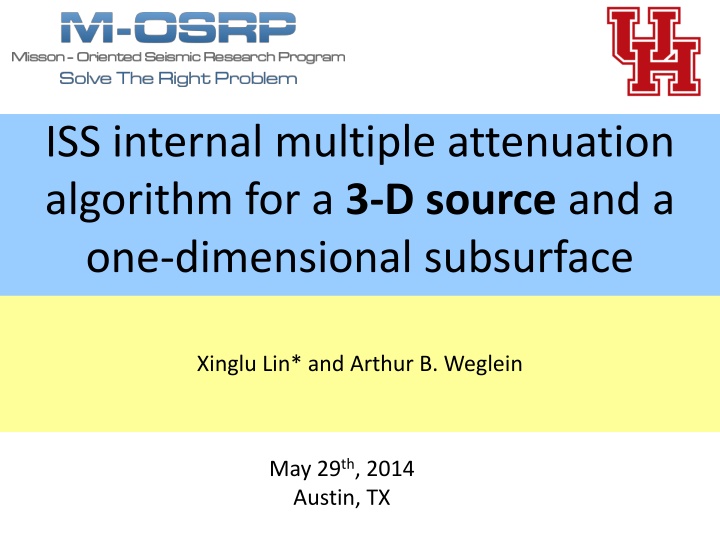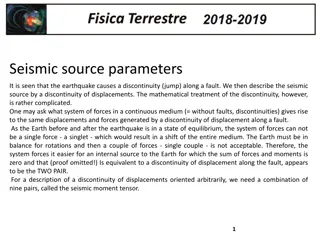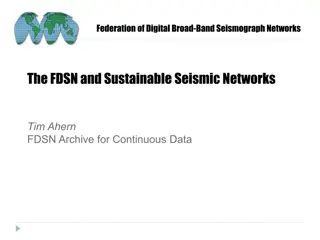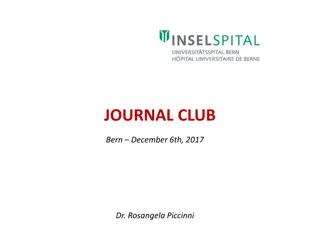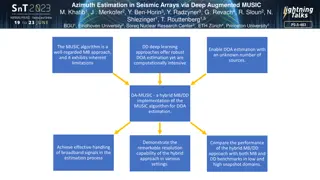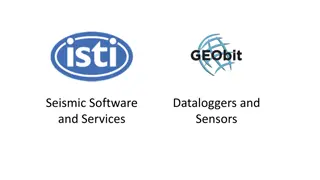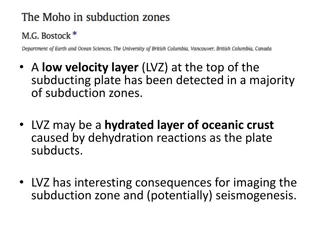Enhanced Algorithm for Internal Multiple Attenuation in Seismic Imaging
This research discusses the development of an improved algorithm for internal multiple attenuation in seismic imaging. The focus is on addressing the challenges in onshore and offshore regions close to a 1-D earth model. The algorithm aims to enhance the efficiency and accuracy of data processing in such scenarios, offering a cost-effective solution. Various perspectives on the current state of internal multiple attenuators and the requirements for a 3-D approach are explored. The study presents insights on reduced forms of 3-D source-1-D earth algorithms, motivation, numerical testing, and conclusions.
Download Presentation

Please find below an Image/Link to download the presentation.
The content on the website is provided AS IS for your information and personal use only. It may not be sold, licensed, or shared on other websites without obtaining consent from the author.If you encounter any issues during the download, it is possible that the publisher has removed the file from their server.
You are allowed to download the files provided on this website for personal or commercial use, subject to the condition that they are used lawfully. All files are the property of their respective owners.
The content on the website is provided AS IS for your information and personal use only. It may not be sold, licensed, or shared on other websites without obtaining consent from the author.
E N D
Presentation Transcript
ISS internal multiple attenuation algorithm for a 3-D source and a one-dimensional subsurface Xinglu Lin* and Arthur B. Weglein May 29th, 2014 Austin, TX
2 Outline Motivation; Reduced form of 3-D ISS internal multiple attenuator for a 1-D layered earth: Circular symmetry; 3-D source ISS internal multiple attenuator for a 1-D earth; Numerical test; Conclusions.
3 Outline Motivation; Reduced form of 3-D ISS internal multiple attenuator for a 1-D layered earth: Circular symmetry; 3-D source ISS internal multiple attenuator for a 1-D earth; Numerical test; Conclusions.
4 Motivation There are on-shore and off-shore regions, which are close to 1-D earth and have serious internal multiple problems. For example, Central North sea (B. Duquet, 2013), Canada, offshore Brazil and Middle East. When the earth is close to 1-D, we do not have to pay for a complete data set and high computation as in 3-D earth by using the reduced 3-D source-1-D earth algorithm; 3-D source 1-D earth ISS internal multiple attenuator is needed for the ISS eliminator of internal multiple.
5 Motivation - Current state of ISS internal multiple attenuator 2-D Line Source: 2-D algorithm assume that whole world is 2-D. A point source in the 2-D world is a line in a 3-D world. 2-D source-1-D earth: The algorithm is derived from 2-D source, which is a reduced form for a 1-D earth. It requires one source and receivers on one single line. (Araujo, et al,1994; Weglein, et al,1997) code released by P. Terenghi; S. Kaplan; Application: Qiang Fu, Encana data, 2014 M-OSRP annual report
6 Motivation - Current state of ISS internal multiple attenuator 3-D Point Source: In 3-D theory the world is considered as 3-D. Source is a point in a 3-D world. 3-D Source-3-D Earth 3-D Source-2-D Earth 3-D Source-1-D Earth (in Cartesian Coordinates) 3-D Source-1-D Earth (in Cylindrical Coordinates)
7 Requirements of 3-D ISS internal multiple attenuator 3-D Source-3-D Earth 3-D Source-2-D Earth 3-D Source-1-D Earth (in Cartesian Coordinates) 3-D Source-1-D Earth (in Cylindrical Coordinates)
8 3-D Source-3-D Earth X-direction Source Receiver Z Y X Requirements: Areal coverage of sources; Areal coverage of receivers.
9 3-D Source-3-D Earth X-direction Source Receiver Z Y X Requirements: Areal coverage of sources; Areal coverage of receivers.
10 3-D Source-3-D Earth X-direction Source Receiver Z Y X Requirements: Areal coverage of sources; Areal coverage of receivers.
11 3-D Source-3-D Earth X-direction Source Receiver Z Y X Requirements: Areal coverage of sources; Areal coverage of receivers.
12 3-D Source-3-D Earth X-direction Source Receiver Z Y X Requirements: Areal coverage of sources; Areal coverage of receivers.
13 3-D Source-3-D Earth X-direction Source Receiver Z Y X Requirements: Areal coverage of sources; Areal coverage of receivers.
14 3-D Source-3-D Earth Y-direction Source Receiver Z Y X Requirements: Areal coverage of sources; Areal coverage of receivers.
15 3-D Source-3-D Earth Y-direction Source Receiver Z Y X Requirements: Areal coverage of sources; Areal coverage of receivers.
16 3-D Source-3-D Earth Y-direction Source Receiver Z Y X Requirements: Areal coverage of sources; Areal coverage of receivers.
17 3-D Source-3-D Earth Y-direction Source Receiver Z Y X Requirements: Areal coverage of sources; Areal coverage of receivers.
18 3-D Source-3-D Earth Y-direction Source Receiver Z Y X Requirements: Areal coverage of sources; Areal coverage of receivers.
19 3-D Source-3-D Earth Y-direction Source Receiver Z Y X Requirements: Areal coverage of sources; Areal coverage of receivers.
20 3-D Source-3-D Earth Source Receiver Z Y X Requirements: Areal coverage of sources; Areal coverage of receivers.
21 Requirements of 3-D ISS internal multiple attenuator 3-D Source-3-D Earth 3-D Source-2-D Earth 3-D Source-1-D Earth (in Cartesian Coordinates) 3-D Source-1-D Earth (in Cylindrical Coordinates)
22 3-D Source-2-D Earth Source Receiver Z Y X Requirements: Sources on a single line (x-direction); Areal coverage of receivers.
23 3-D Source-2-D Earth Source Receiver Z Y X Requirements: Sources on a single line (x-direction); Areal coverage of receivers.
24 3-D Source-2-D Earth Source Receiver Z Y X Requirements: Sources on a single line (x-direction); Areal coverage of receivers.
25 3-D Source-2-D Earth Source Receiver Z Y X Requirements: Sources on a single line (x-direction); Areal coverage of receivers.
26 3-D Source-2-D Earth Source Receiver Z Y X Requirements: Sources on a single line (x-direction); Areal coverage of receivers.
27 3-D Source-2-D Earth Source Receiver Z Y X Requirements: Sources on a single line (x-direction); Areal coverage of receivers.
28 3-D Source-2-D Earth Source Receiver Z Y X Requirements: Sources on a single line (x-direction); Areal coverage of receivers.
29 3-D Source-2-D Earth Source Receiver Z Y X Requirements: Sources on a single line (x-direction); Areal coverage of receivers.
30 Requirements of 3-D ISS internal multiple attenuator 3-D Source-3-D Earth 3-D Source-2-D Earth 3-D Source-1-D Earth (in Cartesian Coordinates) 3-D Source-1-D Earth (in Cylindrical Coordinates)
31 3-D Source-1-D Earth (Cartesian Coordinates) Source Receiver Z Y X Requirements: One single source; Areal coverage of receivers.
32 Requirements of 3-D ISS internal multiple attenuator 3-D Source-3-D Earth 3-D Source-2-D Earth 3-D Source-1-D Earth (in Cartesian Coordinates) 3-D Source-1-D Earth (in Cylindrical Coordinates)
33 3-D Source-1-D Earth (Cylindrical Coordinates) Source Receiver r q Z Y X Requirements: One single source; Receivers on one single line.
34 3-D Source-1-D Earth (Cylindrical Coordinates) Source Receiver Z Y X Requirements: One single source; Receivers on one single line.
35 Motivation - Current state of ISS internal multiple attenuator 3-D Point Source: 1-D earth-3-D source: Current algorithm requires a shot record with areal coverage of receivers (all the xg and yg) for a fixed source (xs, ys). In this presentation, the ISS internal multiple attenuator will be changed into cylindrical coordinates for a 3-D source and a 1-D earth, which allows a single source and receivers on a single line, rather than a full surface of receivers.
36 Motivation This presentation will examine what difference the 3-D source attenuation algorithm makes versus current 2-D line source algorithm for a data generated by a 3-D source and a 1-D earth. The difference will be amplified when the attenuator b3 enters the elimination algorithm, e.g., that Yanglei Zou and Dr. Weglein are developing. The ISS internal multiple eliminator is an important step in the three-pronged strategy.
37 M-OSRP The three-pronged strategy Preprocessing for on-shore applications. Beyond the ISS internal multiple attenuator. 1. elimination: Start the ISS internal multiple attenuator for a 3D source - 1D earth at first. 2. spurious events removal. New adaptive subtraction criteria. I. II. III.
38 Outline Motivation; Reduced form of 3-D ISS internal multiple attenuator for a 1-D layered earth: Circular symmetry; 3-D source ISS internal multiple attenuator for a 1-D earth; Numerical test; Conclusions.
39 Cylindrical Coordinate 3-D source-1-D earth data only depends on offset and frequency, which has a circular symmetry under cylindrical coordinate (independent of angle). y y r x x
40 Circular Symmetry 3D-1DE-----3D source, 1-D earth; Circular symmetry after a two-dimensional Fourier transform or a Fourier-Bessel transform. 3D-1DE Applying the symmetry to b1 gives a product of and a symmetry factor. b1
41 Outline Motivation; Reduced form of 3-D ISS internal multiple attenuator for a 1-D layered earth: Circular symmetry; 3-D source ISS internal multiple attenuator for 1-D earth; Numerical test; Conclusions.
42 3-D ISS internal multiple attenuation algorithm in cylindrical coordinate (1-D earth, k- domain) The circular symmetry produces the simple form, which is reduced from original 3-D ISS attenuation algorithm: k- domain: 3D-1DE(krh,w) + b3 + z1 3D-1DE(krh,z2)e-i2qz2 3D-1DE(krh,z1)ei2qz1 3D-1DE(krh,z3)ei2qz3 = dz1 b1 dz2 b1 dz3 b1 - - z2 = = = ( /c ) 2 2 rh , wherek k k q k 0 rh rg rs
43 3-D ISS internal multiple attenuation algorithm in cylindrical coordinate (1-D earth, Hankel Transform, r- (x- ) domain ) Fourier-Bessel transform over the b3. The reduced 3-D algorithm is, r- (x- ) domain: Hankel Transform
44 3-D ISS internal multiple attenuation algorithm for 1-D earth For example, to deal with a shot record generated by 3-D source-1-D earth, we need to do 3-D source -1-D earth data 3D-1DE(krh,w) b1 3D-1DE(krh,w) b3 3D-1DE(rh,w)Inverse Hankel transform b3 Or using asymptotic Bessel function krh 3D-1DE(rh,w)=1 3D-1DE(krh,w) eikrhrhdkrh b3 b3 2p 2iprh -
45 Comparison between 3-D source and 2-D source ISS internal multiple algorithm Assumption: 1-D earth krh= kxh (k- ); (x- )---2-D; (r- )---3-D; rh= xh 2D-1DE(kxh,w) = + b1 b3 Fourier Transform b3 =1 2p 2D-1DE(xh,w) 2D-1DE(kxh,z1)ei2qz1 2-D dz1 - z1 line source ISS attenuator 2D-1DE(kxh,w) eikxhxhdkxh b3 2D-1DE(kxh,z2)e-i2qz2 dz2 b1 - - + 2D-1DE(kxh,z3)ei2qz3 dz3 b1 z2 3D-1DE(rh,w) b3 =1 Hankel Transform 3D-1DE(krh,w) = + b1 b3 3D-1DE(krh,w)krhdkrh 0(khrh) b3 J 3-D 3D-1DE(krh,z1)ei2qz1 2p dz1 0 - z1 point source ISS attenuator 3D-1DE(rh,w) 3D-1DE(krh,z2)e-i2qz2 Asymptotic Bessel b3 dz2 b1 - + krh 1 3D-1DE(krh,w) eikrhrhdkrh = b3 3D-1DE(krh,z3)ei2qz3 dz3 b1 2p 2iprh - z2
46 Comments From the above chart, we can conclude that the 3-D source ISS internal multiple attenuation algorithm remains all its merits for a 1-D earth, since the prediction kernel does not change.
47 Outline Motivation; Reduced form of 3-D ISS internal multiple attenuator for a 1-D layered earth: Circular symmetry; 3-D source ISS internal multiple attenuator for a 1-D earth; Numerical test; Conclusions.
48 Numerical Test 3-D source C0=1000m/s, 0=1g/cm3 30m C1=2000m/s, 1=2g/cm3 50m C2=8000m/s, 2=4g/cm3
49 Assumptions and 3-D source-1-D earth data Assumptions: 1. 1-D earth; = k k 2. 3-D source (on streamer, no lateral offset, ); rh rx 3. Transform data from spatial-frequency domain to wavenumber-frequency transform before multiple prediction. by using Fourier-Bessel Data is generated in (krh,q) domain. ( Aki and Richard, Chapter 6)
3-D source-1-D earth data, 2-D Prediction, 3-D Prediction with full bandwidth 50 primary I primary II Internal multiple 3-D earth-1-D earth data set (one streamer) (courtesy of Yanglei Zou) 3-D ISS internal multiple prediction ( Hankel transformation) 2-D ISS internal multiple prediction 3-D ISS internal multiple prediction (Asymptotic Bessel)
